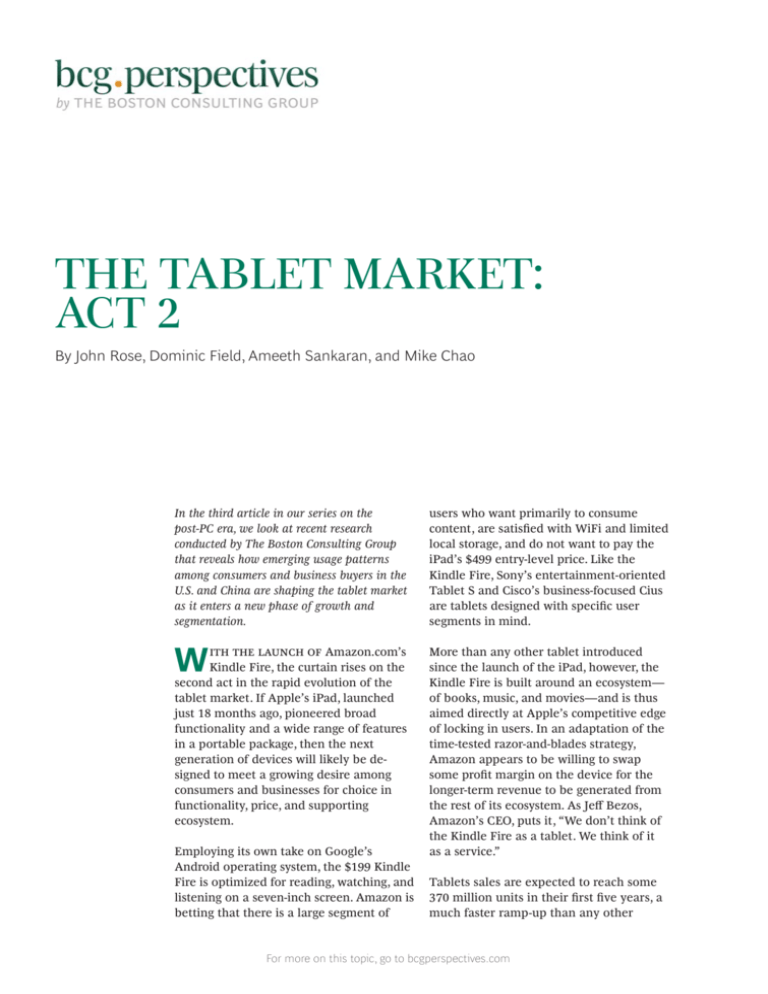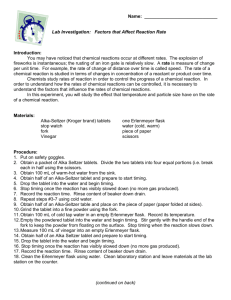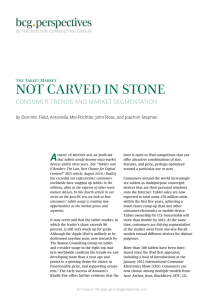
THE TABLET MARKET:
ACT 2
By John Rose, Dominic Field, Ameeth Sankaran, and Mike Chao
In the third article in our series on the
post-PC era, we look at recent research
conducted by The Boston Consulting Group
that reveals how emerging usage patterns
among consumers and business buyers in the
U.S. and China are shaping the tablet market
as it enters a new phase of growth and
segmentation.
users who want primarily to consume
content, are satisfied with WiFi and limited
local storage, and do not want to pay the
iPad’s $499 entry-level price. Like the
Kindle Fire, Sony’s entertainment-oriented
Tablet S and Cisco’s business-focused Cius
are tablets designed with specific user
segments in mind.
W
More than any other tablet introduced
since the launch of the iPad, however, the
Kindle Fire is built around an ecosystem—
of books, music, and movies—and is thus
aimed directly at Apple’s competitive edge
of locking in users. In an adaptation of the
time-tested razor-and-blades strategy,
Amazon appears to be willing to swap
some profit margin on the device for the
longer-term revenue to be generated from
the rest of its ecosystem. As Jeff Bezos,
Amazon’s CEO, puts it, “We don’t think of
the Kindle Fire as a tablet. We think of it
as a service.”
Amazon.com’s
Kindle Fire, the curtain rises on the
second act in the rapid evolution of the
tablet market. If Apple’s iPad, launched
just 18 months ago, pioneered broad
functionality and a wide range of features
in a portable package, then the next
generation of devices will likely be designed to meet a growing desire among
consumers and businesses for choice in
functionality, price, and supporting
ecosystem.
Employing its own take on Google’s
Android operating system, the $199 Kindle
Fire is optimized for reading, watching, and
listening on a seven-inch screen. Amazon is
betting that there is a large segment of
Tablets sales are expected to reach some
370 million units in their first five years, a
much faster ramp-up than any other
For more on this topic, go to bcgperspectives.com
consumer-electronics or mobile device.
The iPad has powered this growth, of
course, and its general-purpose design
strives to meet the needs of all kinds of
users. As consumer and business demand
for tablets starts to diverge from a onesize-fits-all model, however, different
devices will become attractive at different
price points. Exhibit 1 shows how consumers are already tailoring their usage,
especially in content consumption. Our
research found that on a given day, the
average tablet user spends 35 percent
more time on all of his or her devices than
the average nonuser of tablets does—with
especially significant increases in watching
videos, gaming, listening to music, and
e-reading. And that’s before grievances
such as inadequate battery life are fully
addressed.
years. (This survey is part of a broad,
ongoing research effort into tablet usage, a
comprehensive update of which will be
available soon.)
We believe that these usage patterns will
continue. When BCG asked respondents
whether they plan to shi the various
activities that they now perform primarily
on desktops and notebooks to other
devices, more than half said that they
intend to move such functions as personal
e-mail, videoconferencing, and e-reading to
tablets or smartphones in the next two
Thirty entrants are releasing more than
100 devices in 2011; clearly, they will not
all succeed. (See Exhibit 2 for information
about some of the new devices.) Although
the consumer market has already claimed
one major victim in Hewlett-Packard’s
TouchPad, the new devices give users a
variety of choices—with a wide range of
price points and capability combinations.
Our research indicates that tablet ownership by U.S. households will more than
double by 2013. This finding is consistent
with industry projections of worldwide tablet shipments rising from an estimated
55 million in 2011 to 102 million in 2013,
with volume split almost evenly among the
U.S., Europe, and Asia.
We estimate that some 75 percent of U.S.
tablet volume in 2013 will constitute new
sales; the remainder will cannibalize
existing devices—principally netbooks,
which have suffered plummeting sales
since the launch of the iPad.
E | Tablets Are Driving New Usage Patterns Among Consumers
Tablet nonusers
Change in usage
Increase/decrease
Tablet users
Net
new usage
Cannibalized
usage
E-mail
Other activities 19
96
18
112
16
Social networking 20
17
37
Games 20
11
31
File editing/creating 35
52
17
Other work soware 20
4
24
Videos 13
17
30
Music 17
17
34
E-reading 5
14
19
14
17
New usage
Videoconferences 3
0
50
100
–40 –20
Average
daily minutes
Desktop
91
–1
Internet
Some new
usage and
some
cannibalized
usage
–9
100
Notebook
Netbook
E-reader
0
20
40
Average
daily minutes
Smartphone
0
50 100 150
Average
daily minutes
Tablet
Source: BCG survey.
| T T M: A
E | Many Products, Fewer Winners?
Price ($)
800
Cisco Cius
Blackberry PlayBook
Huawei
Ideos
Barnes &
Noble Nook
400
HTC Flyer
Samsung Galaxy Tab
Dell Streak 7
High-end
price range
Sony Apple iPad2
Tablet S
LG G-Slate
Motorola Xoom
Lenovo ThinkPad
Samsung Galaxy Tab
Toshiba Thrive
Asus Eee Pad
Acer Iconia A500
“Crowded”
mid-market
price range
Low-end
price range
Amazon Kindle Fire
Amazon Kindle
0
6
7
9
8
10
11
Screen size (inches)
iOS
Android
Other
Source: Analyst reports; company websites; BCG analysis.
Note: The sample includes only listed products from the largest manufacturers. Some prices are forecasted. The
HP TouchPad is still available, but not shown (discontinued). Prices are shown for the mid-range product option if
multiple price options exist for the same screen size.
It’s only a matter of time until we see
low-cost single- or dual-function tablets
designed for specific user segments, as well
as increasingly powerful devices that seek
to outperform the current iPad in areas
such as professional content creation and
business document creation and communications, targeting users for whom performance trumps price. More than 40 percent
of tablet consumers in the U.S. desire a
tablet that runs Windows; and the interest
rises to 53 percent of the market when
nonusers of tablets are factored into the
equation. (This result is strikingly similar
in China, where 44 percent of consumers
would prefer to have Windows on their
tablets.)
Cisco’s Cius aside, the enterprise market
has yet to be effectively tapped. Although
vertical applications of tablets have been
trumpeted in health care, field service
productivity, and even in general management, product offerings and related usage
remain sporadic. More oen than not, business tablet usage is led by employees who
bring their personal devices to work.
Companies such as Salesforce.com are
pioneering customer-relationship-management applications; new apps are offered
almost daily for computer-aided design,
film, and video production; and big compa-
nies are directing their IT departments to
develop business-specific apps. One key to
accelerated acceptance will be a high-capability professional machine that is geared
to run productivity applications and
facilitates content creation as well as
consumption—a product that does not yet
exist but doubtless is on the way.
Apple has established the dominant
consumer-oriented ecosystem so far, but
others are staking their claim—Google,
Amazon, and Microso among them. At
the same time, smaller, more focused
ecosystems could well spring up around
devices designed for a specific function,
geography, or user segment. In places such
as China where the landscape is dominated by local players, an ecosystem that
outfoxes the worldwide giants and caters
to local needs could easily form.
Although tablet penetration of the total
device market won’t hit double digits for
another couple of years, technology
players and media companies need to be
agile since the market is evolving swily.
The winners will be those companies that
understand how to address rapidly changing consumer behavior and embed their
offering in an effective ecosystem.
| T T M: A
About the Authors
John Rose is a senior partner and managing
director in the New York office of The Boston
Consulting Group. You may contact him by e-mail
at rose.john@bcg.com.
Dominic Field is a partner and managing director
in the firm’s Los Angeles office. You may contact
him by e-mail at field.dominic@bcg.com.
Ameeth Sankaran is a principal in BCG’s
Dallas office. You may contact him by e-mail at
sankaran.ameeth@bcg.com.
Mike Chao is a principal in the firm’s Beijing
office. You may contact him by e-mail at
chao.mike@bcg.com.
For Further Contact
If you would like to discuss this article, please contact one of the authors.
The Boston Consulting Group (BCG) is a global
management consulting firm and the world’s leading advisor on business strategy. We partner with
clients in all sectors and regions to identify their
highest-value opportunities, address their most
critical challenges, and transform their businesses.
Our customized approach combines deep insight
into the dynamics of companies and markets with
close collaboration at all levels of the client organization. This ensures that our clients achieve sustainable competitive advantage, build more capable organizations, and secure lasting results.
Founded in 1963, BCG is a private company with
74 offices in 42 countries. For more information,
please visit www.bcg.com.
© The Boston Consulting Group, Inc. 2011. All
rights reserved.
10/11
| T T M: A







